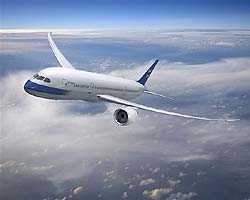Power-on process for the 787 Dreamliner begins
13 Jun 2008
 Boeing said it has begun the 'power-on' process for the 787 Dreamliner this week, a critical step in the aircraft being made ready to meet revised delivery schedules. According to the latest schedules, the first flight for the Dreamliner is slated for the fourth quarter of this year.
Boeing said it has begun the 'power-on' process for the 787 Dreamliner this week, a critical step in the aircraft being made ready to meet revised delivery schedules. According to the latest schedules, the first flight for the Dreamliner is slated for the fourth quarter of this year.
The company said full power-on will very likely be achieved over the coming 10-14 days, following tests of various systems.
The revised schedule, albeit delaying deliveries further, is allowing the harried Boeing production team to proceed with the work in a more sure-footed manner. According to the Dreamliner's systems provider, Hamilton Sundstrand, there were ''technical challenges'' with the aircraft, that both Boeing and Hamilton did not ''fully appreciate.''
The 787 Dreamliner is touted as the most technologically sophisticated aircraft ever produced.
Hamilton is providing the electrical, auxiliary power, air-thermal management, hydraulic, fire protection and engine systems for the Dreamliner. It is producing 600 line items for each 787.
 Hamilton Sundstrand president, David Hess, said last week that the challenges in developing the systems to power the aircraft had partly contributed to the programme's extensive delays. According to Hess, there are at least 1.5 million lines of software code running its systems, which is indicative of the technological complexity of the systems that will power the aircraft.
Hamilton Sundstrand president, David Hess, said last week that the challenges in developing the systems to power the aircraft had partly contributed to the programme's extensive delays. According to Hess, there are at least 1.5 million lines of software code running its systems, which is indicative of the technological complexity of the systems that will power the aircraft.
Talking about delays, Hess pointed out that though these would obviously be unwelcome for client airlines, the example of another hugely delayed project may provide some sobering thoughts. The A380 super jumbo, another aircraft for which Hamilton is a major systems provider, has probably operated more efficiently since its operational launch than it would have minus its production delays.
"I think the fact that [Airbus] had a couple more years paid dividends in terms of maturity," he said. "If they had rushed it into service a couple of years earlier, [initial operations] would have been more bumpy," Hess told the media.